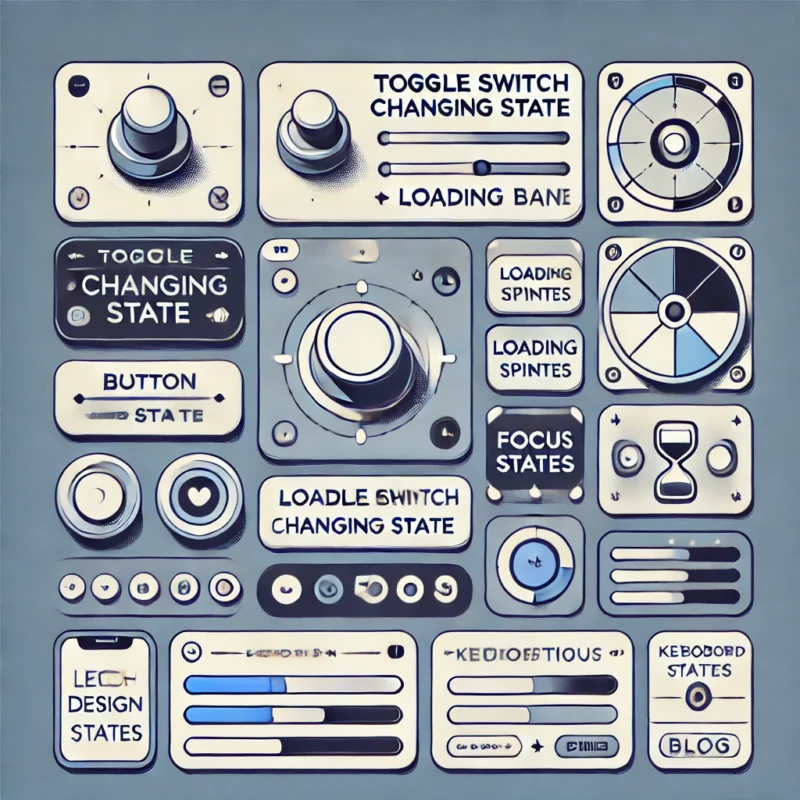
Microinteractions are the tiny details that shape our daily digital experiences. From the satisfying bounce of a toggle switch to a subtle loading spinner or a simple notification toast, these micro-moments may seem small, but they can significantly impact both accessibility and usability. When thoughtfully designed, microinteractions elevate digital products, making them intuitive, inclusive, and delightful to use.
But what happens when microinteractions are poorly designed or entirely inaccessible? This post explores the vital role microinteractions play in user experience, how they affect users with disabilities, and what you can do to ensure your UI’s microinteractions enhance—not hinder—usability for everyone.
What Are Microinteractions?
Coined by Dan Saffer in his book “Microinteractions: Designing with Details,” microinteractions are the single-purpose moments that accomplish one task. They’re the tiny animations and feedback mechanisms that occur around UI events like:
Turning a feature on or off (toggle)
Receiving an error message
Liking a post
Pull-to-refresh
Hover effects on buttons
Password strength indicators
Microinteractions are typically composed of four parts:
Trigger – Initiates the interaction
Rules – Define what happens
Feedback – Communicates changes to the user
Loops and Modes – Determine how the interaction evolves over time
Why Microinteractions Matter
Microinteractions might seem aesthetic at first glance, but they carry real functional weight. They help users:
Understand system status
Receive confirmation or error messages
Navigate tasks with confidence
Avoid mistakes
In terms of accessibility, microinteractions can either reinforce inclusive design or create frustrating barriers. Let’s explore how.
Microinteractions and Accessibility
Accessibility isn’t just about alt text and screen readers. It’s also about how people interact with your interface. Poorly designed microinteractions can confuse, mislead, or even prevent users from completing tasks.
1. Feedback That Everyone Can Perceive
Bad: A loading spinner that only shows as a faint gray animation.
Good: A loading spinner with clear motion and ARIA live regions that announce the loading state to screen readers.
Example:
When a user submits a form, a visible confirmation message and an audio cue help reinforce the success for users who are blind, deaf, or cognitively impaired.
2. Color Contrast and Motion
Many microinteractions rely on color or animation, which may be hard to see or cause discomfort.
Ensure text changes have sufficient contrast.
Avoid using color alone to indicate changes (e.g., red for errors).
Allow users to reduce motion in settings.
Pro Tip: Always respect user preferences such as prefers-reduced-motion in your CSS animations.
3. Keyboard Navigation
A microinteraction should never break when using the keyboard. Hover effects or toggles should also be triggerable via Tab, Enter, and Space.
Checklist for Keyboard-Friendly Microinteractions:
All interactive elements are focusable.
Animations don’t trap focus.
Visual focus indicators are clearly visible.
4. Screen Reader Compatibility
When a toast notification appears, can a screen reader user hear it? Microinteractions like notifications, tooltips, or dynamic error messages should be wrapped with proper ARIA roles and live regions to be announced correctly.
Fix:
Use aria-live="polite" or aria-live="assertive" based on urgency.
Microinteractions and Usability
Even for users without accessibility concerns, microinteractions improve usability by:
Providing context
Reducing cognitive load
Reinforcing user actions
Improving learnability
Examples of Good Usability Practices:
Password strength indicator: Shows real-time feedback.
Undo snackbar: Gives users control after accidental deletion.
Progress bar during uploads: Helps manage time expectations.
But be careful—overusing or misusing microinteractions can lead to distracting or overwhelming experiences.
Designing Inclusive Microinteractions: A Practical Guide
Here’s how you can make sure your microinteractions enhance accessibility and usability:
✅ Always Test with Assistive Technologies
Use screen readers (NVDA, VoiceOver), keyboard-only navigation, and color blindness simulators.
✅ Provide Redundant Cues
Combine text, icons, sound, and animation for feedback.
✅ Respect User Preferences
Reduce motion, simplify interactions, and allow toggling of animation-heavy effects.
✅ Use Semantic HTML and ARIA
Don’t rely on divs for everything. Native HTML elements are more accessible.
✅ Make It Predictable
Avoid surprises. Ensure microinteractions behave consistently.
Accessibility in Action: From Theory to Practice
Imagine a donation form with the following microinteractions:
A real-time validation message when an email is entered
A sliding confirmation toast once payment is processed
A progress bar that updates during submission
Now make it accessible:
Validation message: Should be announced with
aria-liveToast message: Include a visible and audible confirmation
Progress bar: Label with current status for screen readers
These improvements create a seamless, inclusive experience for all users.
Final Thoughts
Microinteractions are often described as “the soul of the product.” When built with accessibility and usability in mind, they can delight, inform, and empower users. But when overlooked, they can create friction, confusion, and exclusion.
Designing accessible microinteractions isn’t about adding more complexity. It’s about ensuring your interface communicates well with every user—clearly, consistently, and respectfully.
Let’s make your design system more inclusive — reach out to our team.
Share: